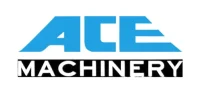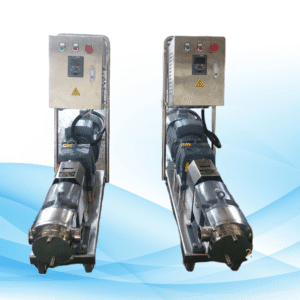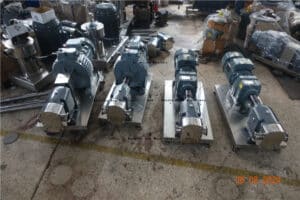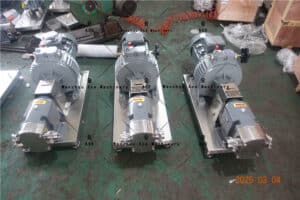A positive displacement pump is a device that transfers fluids by trapping a fixed amount and pushing it through the system. These pumps are particularly good at handling heavy viscous materials and difficult feeds. In fact, many industries rely on them heavily in their operations, including food processing, oil, and water treatment, among others. Positive displacement pumps guarantee accurate dosing and high pressure outputs, thus making them useful in various applications. The primary categories are reciprocating pumps, rotary pumps, and peristaltic pumps, all having their strengths for specific tasks.

Positive Displacement Pumps Overview
Definition and Working Principle
A positive displacement pump captures a certain volume of fluid and displaces it through the system. This ensures a uniform flow rate regardless of changes in pressure. Reciprocating motion and rotary motion are the two main principles upon which positive displacement pumps work.
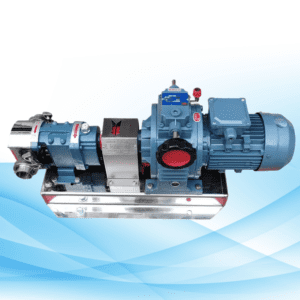
Basic Mechanism
In its basic mechanism, this type of pump traps some quantity of liquid and then pushes it into the discharge pipe. For instance, reciprocating ones achieve this through back-and-forth movement while using pistons, plungers, or diaphragms among other components to aid this motion. On the other hand, rotary ones employ rotating parts like gears, lobes, screws, vanes, etc., for moving the fluid.
Key Components
Some key parts found in positive displacement pumps include:
- Inlet Valve: Allows entry of fluid into the pump chamber.
- Pump Chamber: Where fluid stays during the pumping process.
- Discharge Valve: Regulates the release of liquid from the pump.
- Piston/Plunger/Diaphragm: These create necessary movement for reciprocating types.
- Rotors/Gears/Lobes: Help in moving fluid within rotary types.
Pros and Cons
As with any other machines, there are advantages as well as disadvantages associated with positive displacement pumps.
Pros
The following are some benefits offered by these devices:
- High Pressure: They can produce high pressures, thus suitable for demanding applications.
- Consistent Flow Rate: Deliver a steady flow rate irrespective of pressure changes.
- Versatility: Can handle different fluids including viscous and abrasive substances.
- Accurate Dosing: Ensure precision in fluid delivery, which is vital for the pharmaceuticals industry among others.
Cons
On the other hand, certain drawbacks accompany positive displacement pumps:
- Complexity: More intricate design compared to centrifugal ones, leading to increased maintenance needs.
- Efficiency: Generally less efficient than centrifugal pumps, especially at high flow rates.
- Pulsation: Fluid flow may experience pulsation due to reciprocating types, therefore requiring additional dampening equipment.
Types of Positive Displacement Pumps
Reciprocating Positive Displacement Pumps
Reciprocating pumps, also known as piston pumps, use backward-forwards movement for transferring liquids. These consist of a cylinder where a piston or diaphragm moves. High pressures can be handled by reciprocating pump types, which are capable of working with a wide range of viscosities.
Piston Pumps
In a piston pump, there is a piston that pushes fluid through a cylinder. A vacuum is created by this part, drawing it into the pump chamber. Then the discharge valve opens, allowing the liquid out under pressure before closing again when the new cycle starts. It excels at applications needing high pressures and accurate control over flows.
Diaphragm Pumps
Instead of using a piston, the diaphragm flexes back and forth, thus producing the required action in a diaphragm pump. During one phase, it draws in fluid due to flexing upwards while during another phase, compression takes place, forcing it outwards again until the next stroke begins. Since they isolate moving parts from each other, these devices can handle corrosive or abrasive media without any problems.
Plunger Pumps
The operation of plunger pumps is similar to that of piston pumps, except they use a plunger instead of a piston. The plunger goes back and forth through a static seal to generate high-pressure flow. These types are mostly applied in fields where very high pressures are needed, such as hydraulic systems and water jet cutting.
Rotary Positive Displacement Pumps
Moving fluids through rotating mechanisms constitutes rotary pumping activities. This kind of pump is ideal for viscous liquids and provides a constant rate of flow.
Gear Pumps
Interlocking gears are employed by gear pumps to transfer fluid from one place to another. As the gears rotate, they trap liquid between their teeth and pump casing, thus pushing it towards the discharge port. Gear pumps can be trusted with many different kinds of fluids, including oils and chemicals.
Lobe Pumps
Fluid movement takes place within lobe pumps when rotating lobes push against it. Since lobes do not get into contact with each other, wear or tear is reduced significantly. They handle fluids gently, hence widely used in pharmaceuticals as well as food processing industries.
Screw Pumps
One or multiple screws may be utilized by screw-type positive displacement pumps for conveying liquid via the pump body. Continuous flow with minimum pulsation happens due to rotational motion provided by the screws themselves. The best slurries and highly viscous fluids handling equipment are screw-type positive displacement pumps.
Vane Pumps
A rotor fitted with several vanes serves to move fluid within vane pumps. These vanes slide in and out while rotating, thereby trapping and pumping them throughout the whole system. Vane pumps have great versatility, which enables them to handle a wide range of viscosity fluids, including those with variable viscosities.
Peristaltic Positive Displacement Pumps
Wave-like compression and release motion squeeze flexible tubes creating a vacuum that draws and pushes it to the other end, called peristalsis. Periclinal rotation compresses the walls, sealing them off against each other, thus preventing backflow while squeezing forward.
Working Mechanism
The working mechanism of a peristaltic pump involves rollers or shoes that compress the flexible tube. This compression creates a seal, preventing backflow and ensuring a consistent flow rate. The rollers or shoes move along the tube, pushing the fluid forward.
Applications
Peristaltic pumps are used in applications where contamination must be avoided. The fluid only contacts the inside of the tube, making these pumps ideal for medical, pharmaceutical, and food processing applications. Peristaltic pumps are also used for dosing chemicals and handling abrasive or viscous fluids.
Characteristics and Selection Criteria
Performance Characteristics
Flow Rate
Flow rate measures the volume of fluid a pump moves over a specific period. Positive displacement pumps provide a consistent flow rate regardless of pressure changes. This characteristic ensures precise fluid handling in applications like dosing chemicals or pharmaceuticals.
Pressure
Pressure indicates the force exerted by the pump to move fluid through the system. Positive displacement pumps show excellent performance when it comes to creating high pressures. This makes them suitable for hydraulic systems and high-pressure cleaning, among others.
Efficiency
Efficiency evaluates the energy consumption of the pump relative to its output. Positive displacement pumps generally have lower efficiency than centrifugal ones, but their ability to handle viscous liquids at steady rates often compensates for this drawback. Also, positive displacement pumps can work with slurries.
Factors to Consider When Choosing a Positive Displacement Pump
Type of Fluid
The pump selection is highly influenced by the fluid involved. Positive displacement pumps can handle different kinds of fluids such as viscous, abrasive, corrosive, and other substances. For example, due to the isolation of the fluid from moving parts, diaphragm pumps work best with corrosive fluids.
Operating Conditions
Consideration should be given to operating conditions like temperature, pressure, and environmental factors, among others. Screw pumps may perform well under high-temperature conditions. Knowing what exactly is needed for an application ensures that a pump performs optimally and lasts longer.
Maintenance Requirements
Another thing is that there are various types of positive displacement pumps, which all have different maintenance needs. Reciprocating ones tend to need more attention due to their complex design with many moving parts, while rotary ones, such as gear pumps, require less frequent servicing. Evaluating these requirements against available capabilities will enable one to choose a pump that aligns with their operational abilities and budget limits too.
Case Studies
Positive Displacement Pump Case Studies in Industry are meant to illustrate how these machines can be used practically, showing their benefits in different applications. Pumps’ performance characteristics and selection criteria also become clear through them, thus equipping one with useful information that informs the decision-making process.
When businesses understand these features and plus points, they can make an informed choice on the right positive displacement pump for their specific needs. This saves time and ensures efficiency in dealing with liquids across different tasks or jobs done by a company.
Understanding various kinds of positive displacement pumps is critical in many sectors. Each type, whether it is reciprocating, rotary, peristaltic, etc., has its own advantages over others based on specific uses. Therefore, besides the type, other factors such as the nature of the liquid being moved, speed required, among others, should also come into play when selecting an appropriate machine for any given task or operation.
Going deeper into technical aspects of these devices may result in knowledgeable decisions which could lead to better performance. It would be necessary, therefore, for professionals to look at positive displacement pumps’ mechanics and areas of application so as to tap full potential from them.
